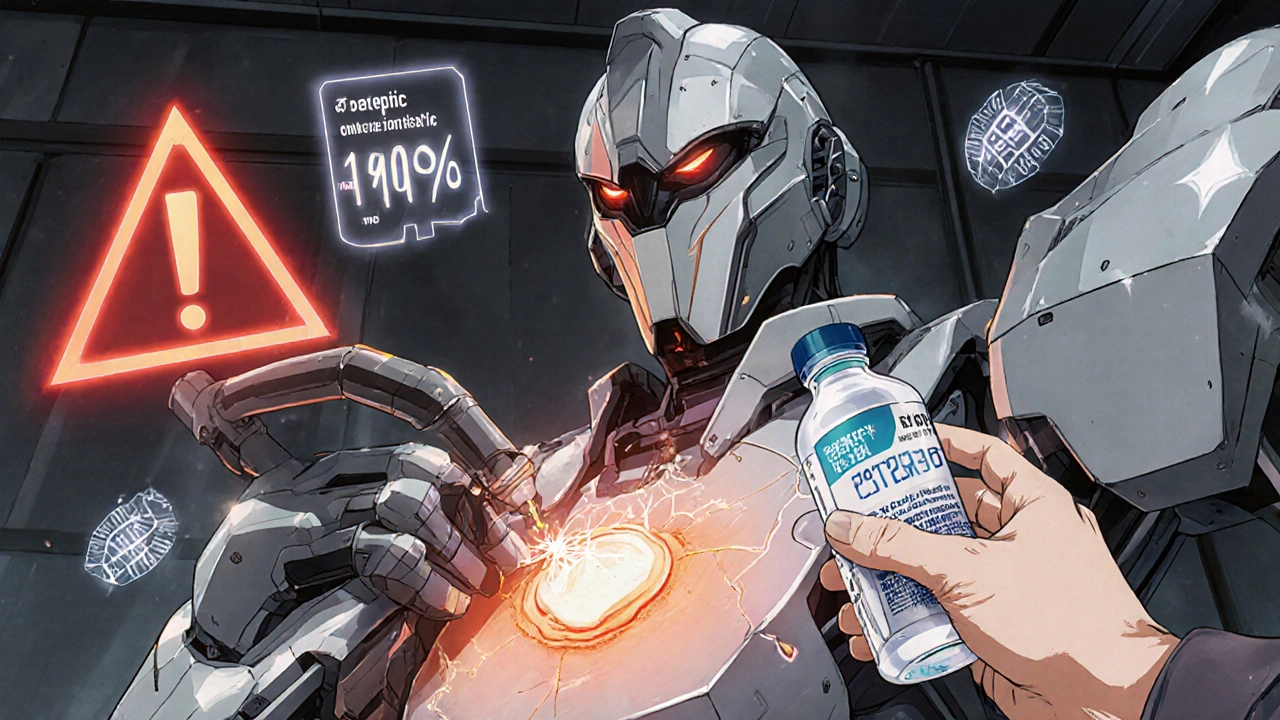
What You Need in Your First Aid Kit
Most people think a first aid kit is just a box with bandages and gauze. But if you’re serious about handling minor injuries at home, you need the right OTC first aid medications too. Antiseptics, antibiotic ointments, and pain relievers aren’t optional extras-they’re the core tools that stop small problems from turning into big ones. A cut that gets cleaned right won’t get infected. A sprain treated with the right painkiller won’t keep you off your feet for days. And knowing which one to use-and which one to avoid-can make all the difference.
Antiseptics: Clean the Skin, Not the Wound
You’ve probably reached for hydrogen peroxide or rubbing alcohol the second you cut yourself. But here’s the truth: pouring those directly on an open wound does more harm than good. Hydrogen peroxide (3%) and isopropyl alcohol (60-70%) are great for cleaning the skin around a cut, but they kill healthy tissue when applied inside. That slows healing and increases scarring.
Instead, rinse the wound with clean water or saline first. Then use a cotton swab dipped in antiseptic to gently wipe the skin surrounding the injury. This kills germs without damaging the healing tissue underneath. Povidone-iodine (5-10%) is another solid option-it’s less stingy than alcohol and kills a wider range of bacteria. One study showed it reduces bacterial load by 99.8% in wounds, compared to 92.3% for hydrogen peroxide.
But watch out. Alcohol stings in 87% of users. Hydrogen peroxide loses its strength after 30 days once opened. And povidone-iodine stains skin and clothes. Keep these in airtight containers, away from sunlight, and check expiration dates. If it’s been sitting in your drawer since last summer, toss it. Efficacy drops by 40-60% past the printed date.
Antibiotic Ointments: Prevent Infection, Not Speed Healing
Antibiotic ointments like Neosporin are popular-but often misunderstood. They don’t heal wounds faster. They prevent infection. That’s it. And they work best when used correctly.
After cleaning the wound and letting it dry, apply a thin layer of triple-antibiotic ointment (bacitracin, neomycin, and polymyxin B). Cover it with a clean bandage if needed. This simple step cuts infection risk by over 90%, according to a Mayo Clinic study of 1,247 minor wounds. Neosporin leads the market with 68% brand recognition, and for good reason: it’s effective.
But not everyone can use it. About 5.2% of people are allergic to neomycin, one of its ingredients. Signs? Redness, itching, swelling that gets worse after application. If that happens, switch to a bacitracin-only ointment. It’s just as good at preventing infection, without the allergy risk.
Also, don’t stockpile these. Once opened, they lose 15% of their potency each year. Even if it looks fine, replace it every 12 months. That’s the rule at the University of Nebraska-Lincoln Health Center. And never use leftover ointment from last year’s cut. It’s not worth the risk.

Pain Relief: Know the Difference Between Acetaminophen, Ibuprofen, and Aspirin
When your head throbs, your knee aches, or you’ve got a fever, you reach for pain relief. But not all OTC painkillers are the same. Choosing the wrong one can mean less relief-or worse, side effects.
- Acetaminophen (Tylenol): Best for headaches, fever, or pain not caused by inflammation. It’s gentler on your stomach than NSAIDs. But here’s the catch: more than 3,000mg a day can damage your liver. Stick to 325-1,000mg per dose, max 4,000mg daily. If you drink alcohol regularly, cut that in half.
- Ibuprofen (Advil, Motrin): Ideal for swelling, sprains, menstrual cramps, or post-surgery pain. It’s an NSAID, so it reduces inflammation. But it can irritate your stomach-1.2% of regular users develop bleeding ulcers. Take it with food. Don’t use it long-term. Max dose: 1,200mg daily.
- Aspirin: Works for pain and fever, but it’s mostly known for one life-saving use: heart attack. Chewing a 325mg tablet at the first sign of chest pain can cut death risk by 30% if taken within 30 minutes. But don’t give it to kids under 18-it can cause Reye’s syndrome. Also avoid if you have a bleeding disorder.
- Naproxen sodium (Aleve): Lasts up to 12 hours, so fewer doses. But it carries higher heart and kidney risks, especially if you’re over 65 or have high blood pressure. Use only for short-term relief.
Studies show ibuprofen works better for inflammation-based pain (68% effective), while acetaminophen wins for non-inflammatory pain like toothaches (73% effective). Pick based on the cause, not just what’s cheapest.
Storage, Expiration, and Common Mistakes
Having the right meds means nothing if they’re useless when you need them.
- Temperature matters. Keep everything below 86°F (30°C). Heat degrades acetaminophen by 35% after two weeks in a hot car or bathroom cabinet.
- Check expiration dates. The American Red Cross says 73% of home first aid kits have expired items. Make it a habit to check twice a year-when you change your smoke detector batteries or reset your clocks.
- Use the right tool. Don’t guess doses with kitchen spoons. Use the measuring cup or syringe that came with the bottle. A teaspoon isn’t a milliliter. And overdosing is the #1 cause of OTC medication errors.
- Don’t use hydrogen peroxide on deep cuts. One Reddit user reported a cut took 10 extra days to heal because they used it inside the wound. Water and gentle cleaning work better.

When to See a Doctor
OTC meds are for minor issues. If you find yourself using them every day for more than a few days, it’s time to call a doctor. Chronic pain, recurring infections, or fever that won’t break aren’t something pills can fix. They’re signs something deeper is wrong.
Dr. Sarah Johnson from Cleveland Clinic says: “Read the Drug Facts label. Follow it. Don’t mix meds unless a doctor says so.” And if you’re unsure? Call your pharmacist. They’re trained to spot dangerous combinations and hidden risks.
What to Keep in Your Kit
Here’s a simple, no-fluff list based on expert recommendations:
- 3% hydrogen peroxide or povidone-iodine (for skin around wounds)
- Triple antibiotic ointment (or bacitracin-only for sensitive skin)
- Acetaminophen (325mg tablets)
- Ibuprofen (200mg tablets)
- Aspirin (325mg chewable tablets)
- Calibrated measuring spoon or oral syringe
- Disposable gloves and clean gauze
Store it in a cool, dry place-not the bathroom. Check it every six months. Replace anything expired or dried out. Keep it small enough to grab in a hurry.
What’s Changing in OTC First Aid
The science isn’t standing still. Johnson & Johnson is testing extended-release ibuprofen patches for longer pain control without swallowing pills. Harvard researchers are experimenting with probiotic-infused antibiotic ointments to fight resistant bacteria. These are still in labs, but they show where things are headed.
For now, though, the basics still work. Clean the skin. Prevent infection. Manage pain wisely. That’s the foundation of every good first aid kit.
Can I use hydrogen peroxide directly on a cut?
No. Hydrogen peroxide damages healthy tissue and slows healing. Use it only to clean the skin around the wound, not inside it. Rinse the wound with water or saline instead.
Is Neosporin better than generic antibiotic ointments?
Neosporin is effective and widely trusted, but it contains neomycin, which can cause allergic reactions in about 5% of people. Generic triple-antibiotic ointments work just as well. If you get redness or itching, switch to a bacitracin-only version.
Which pain reliever is safest for daily use?
None are meant for daily use. If you need pain relief every day for more than a few days, see a doctor. Acetaminophen is gentler on the stomach than ibuprofen, but too much can harm your liver. Ibuprofen can cause stomach bleeding. Long-term use of any OTC painkiller masks underlying problems.
Can I keep aspirin in my first aid kit for heart attack emergencies?
Yes. Chewable aspirin (325mg) is recommended during suspected heart attack symptoms. It can reduce death risk by 30% if taken within 30 minutes. But only use it if you’re not allergic and don’t have a bleeding disorder. Call emergency services immediately after.
How often should I replace items in my first aid kit?
Check every six months. Replace antiseptics and antibiotic ointments after 12 months, even if they look fine. Pain relievers can last 2-3 years past expiration if stored properly, but don’t risk it. Expired meds lose potency and can be unsafe.
Are OTC painkillers safe for kids?
Acetaminophen and ibuprofen are safe for children when dosed correctly by weight. Never give aspirin to anyone under 18-it can cause Reye’s syndrome, a rare but deadly condition. Always use the pediatric measuring tool, not a kitchen spoon.

Jenny Lee
November 19, 2025 AT 03:26Just grabbed my first aid kit after reading this-turned out half the stuff was expired. Time to clean house.
Joshua Casella
November 20, 2025 AT 00:18For real-hydrogen peroxide on open wounds is a myth that refuses to die. Water and gentle cleaning are all you need. Science isn’t optional.
Evan Brady
November 20, 2025 AT 03:22Neosporin isn’t magic-it’s just a branded cocktail of three antibiotics. Most people don’t need all three. Bacitracin alone does the job without the 5% chance of a rash. And yes, it expires. Toss it after a year. Your skin will thank you.
Premanka Goswami
November 21, 2025 AT 21:45They’re testing probiotic ointments? Of course they are. Big Pharma’s already got the patent locked. Meanwhile, we’re still told to use expired Neosporin while the real cure’s buried in a lab somewhere. Wake up.
mithun mohanta
November 23, 2025 AT 02:22Let’s be real: acetaminophen is a slow-burn liver bomb. Ibuprofen? GI nightmare. Aspirin? For heart attacks only-unless you’re into spontaneous bleeding. OTC painkillers are just pharmaceutical roulette. You think you’re in control? You’re not.
Shravan Jain
November 23, 2025 AT 06:09Storage? Temperature? Expiration dates? This is the same level of detail you'd expect from a pharmaceutical manual. Who has time for this? Just pop a pill and move on.
Richard Couron
November 24, 2025 AT 18:46They say don't use hydrogen peroxide inside wounds? LMAO. That's what the CDC told us in 2003. But guess what? The FDA quietly changed guidelines in 2018 and no one talks about it. They want you dependent on ointments. You're being manipulated.
Saket Sharma
November 25, 2025 AT 20:21Neosporin = overpriced placebo. Bacitracin works. Water cleans. Stop wasting money. Also, why is aspirin still in kits? Everyone’s allergic to something. Just use Tylenol and move on.
Kevin Jones
November 27, 2025 AT 13:42There’s a deeper truth here: we treat first aid like a checklist, not a practice. We stockpile pills like ammo, but never learn how to read our own bodies. Healing isn’t a product-it’s a relationship with your own biology.
Ram tech
November 29, 2025 AT 09:05who even uses povidone iodine anymore? just slap on neosporin and call it a day
Erica Lundy
November 30, 2025 AT 08:29The assumption that medical efficacy is linear-clean, apply, heal-is a reductionist illusion. Wounds are not problems to be solved; they are thresholds of biological reorganization. To reduce them to antiseptics and dosages is to mistake the map for the territory.
Alex Boozan
December 2, 2025 AT 07:26They’re pushing probiotic ointments? That’s not innovation-that’s a Trojan horse. If they get us used to lab-engineered microbes on our skin, what’s next? Microchipped bandages? The CDC’s already testing bio-surveillance patches. This isn’t healthcare. It’s surveillance with gauze.
Alexis Paredes Gallego
December 2, 2025 AT 10:52And yet-here’s the twist: the very people who preach ‘don’t use peroxide’ are the same ones pushing triple-antibiotic ointments as the gold standard. Who benefits? The manufacturers. The FDA? The pharmacies? The cycle continues. Question everything-even the ‘experts’.